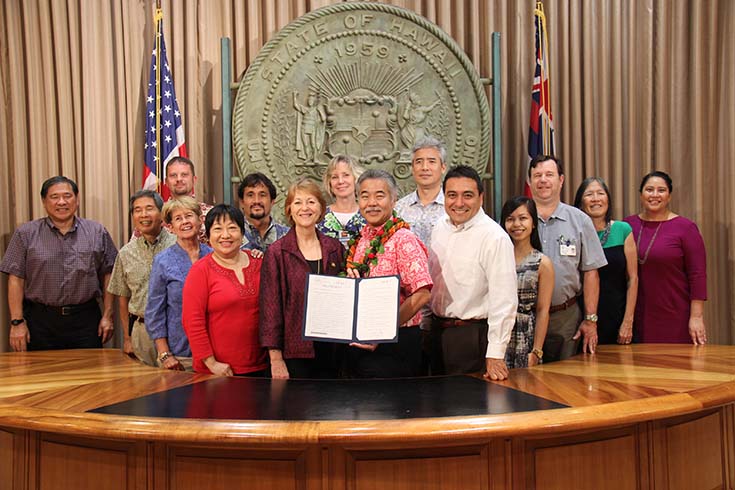 Hawaii Governor David Ige, front right, joined Senator Roz Baker, front left, in a group shot with RTs from the Hawaii Society for Respiratory Care during the signing ceremony on Monday. Photo courtesy of Hawaii Governor.
Hawaii Governor David Ige, front right, joined Senator Roz Baker, front left, in a group shot with RTs from the Hawaii Society for Respiratory Care during the signing ceremony on Monday. Photo courtesy of Hawaii Governor.
April 26, 2016 – A journey that was 30 years in the making came to a close on Monday, when Hawaii Governor David Ige signed a law making the licensure attained for respiratory therapists in the state in 2010 permanent.
Steve Wehrman, RRT, RPFT, AE-C, who has been involved in the battle to achieve licensure in Hawaii since the early 1990s, explains how the process works in his state. “It is a complex process for all new licenses,” says the AARC member. “First a bill is passed to create a Sunrise Audit by the state auditor, which takes a year. Then you can put in a bill. Pass the bill quickly because the audit will expire and you might have to start over.” After the bill does pass, another Sunset Audit is triggered at three years, with an automatic Sunset law triggered after five years. For the profession of respiratory care, the five years were up last year.
“Our audit was positive and strongly supported the license,” says Wehrman. “The state agencies came out in our favor as well.” New legislation was introduced to negate the Sunset provision in the original law and the bill passed with flying colors.
RTs Face An Uphill Battle
It wasn’t always such smooth sailing for licensure in Hawaii. The Hawaii Society for Respiratory Care (HSRC) started on its quest for licensure way back in the mid-‘80s. The first bill that made it through the legislature was vetoed by the governor for procedural reasons. A four-year effort to pass another bill in the 1990s never made it beyond the committee level.
The HSRC came back strong in the 2000s, passing a Sunrise Audit only to be faced with one committee chair in the House who opposed the licensure bill because he thought it would make it impossible to recruit RTs to his rural area of the state. “It took two years to convince this one individual,” recalls Wehrman.
Concerns over the high cost of managing a licensure program for the small number of RTs in the state (about 200 at the time) cratered the next bill, but undaunted, HSRC members came back strong the next year, and with the help of several patient advocates, including one gentleman who credited his RT for saving his life, managed to get the legislation through the legislature and to the governor’s desk, where it was signed into law.
“Learning that respiratory therapists in Hawaii were not licensed and knowing firsthand what valuable members of the patient’s health care team they are, he became the HSRC’s ardent patient advocate for licensure,” says AARC member Jo Ann Ikehara, BS, RRT, CPFT. “He joined us at the capital for every hearing so he could tell his heartfelt life-saving story to the legislators.”
Thank You AARC
The HSRC gives a lot of credit for their ultimate success to the AARC as well. “From the very beginning AARC was our partner,” says Wehrman. “The organization consulted with us every step of the way. They connected us to successful licensure teams in other states. They brought people out to help us.”
AARC Director of Government Affairs Cheryl West receives special praise. “We are so very thankful for the support from the AARC and specifically the support, encouragement, expertise, and timely responses from Cheryl West,” emphasizes AARC member Carol Agard, BS, RRT, RPFT, FAARC. “We would not have been successful without Cheryl’s assistance.”
To recognize her efforts, the state society awarded West their President’s Award in 2015.
Next Steps Ahead
Achieving permanent licensure will go a long way toward improving the care and services available to respiratory patients in Hawaii and Wehrman believes it will help drive other advancements such as greater use of therapists in telehealth as well. “In terms of the bigger picture, we have over 200,000 known individuals with lung disease in a remote island state that has a population of 1.4 million people,” he says. “The legislators now are interested in lung disease because we educated them in the licensure process.”
Indeed, one legislator has already expressed an interest in sponsoring legislation to fund lung health programs. Wehrman envisions a future in which RTs will follow their patients out into the home to prevent readmissions and develop home-based programs for patients who have a hard time getting to the state’s widely scattered health care facilities.
Carol Agard agrees the law will have untold benefits for patients — and believes therapists will see their stature rise as well. “For respiratory patients, it provides security and safety in the provision of respiratory care and will open more doors for access to care by respiratory therapists. For RTs, it provides recognition and professional standing.”
Email newsroom@aarc.org with questions or comments, we’d love to hear from you.










